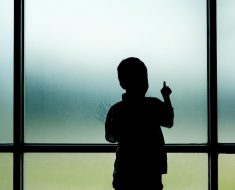Maybe you take your kids to your local LGBTQ Pride celebration every June and have a blast. In which case, carry on! But maybe you’re thinking, "Um, Pride is hot and sweaty, and there’s always way more glitter than is good for you. Why would I bring a child into that?" Or maybe you’re worried that Pride is too "adult" an event — perhaps with too many sexual references for your little angels to be exposed to? Well, maybe it’s time to think again. Here’s why families of all kinds should absolutely bring kids to Pride this year.
More: How to Talk to Kids About Gender
It’s a celebration of diversity
Pride means many things, but above all, it means no shame. There is no shame in seeing two men kiss passionately in the middle of the street — yes, even if their butt cheeks are exposed for the world to see. There is no shame in seeing a scantily clad trans woman strutting her stuff, arm in arm with her beglittered butch bear friend. There is no shame in a butch woman in studded leather chaps growling along on her slick motorbike.
Sure, your kids might catch the odd glimpse of seminudity, but above all what they’ll see is a joyous celebration of being different — people who are unashamed to be themselves and who are joyous in their diversity. And this is far too valuable a lesson to teach our kids to worry about a little playful public seminudity.
Representation matters
It’s important for kids from rainbow families to go to Pride because it shows them they are not alone. Kids who are LGBTQ or who have LGBTQ parents or siblings need to see that there are lots and lots of other people out there just like their family and that they are part of a community that is strong, special and spectacular.
But it’s also important for the kids in straight families to go to Pride. They need to see that there are many different kinds of families out there, many different kinds of ways to look and love (and laugh!) and to learn this in a beautifully positive and colorful environment. We want to teach our kids to be open-minded, accepting and embracing, and we can teach this best by modeling these things ourselves.
And yes, it being June, there will likely be a wide variety of body parts exposed to the elements at Pride, so remember sunscreen and hats for you and your kids as well. But also, all those visible bodies make for a great opportunity to normalize different shapes, sizes and colors of humans — and to show your kids that all types of bodies and all expressions of gender are worth celebrating.
More: How Your Kid Can Be an LGBTQ Activist
It starts important conversations
No, Pride is not inherently "too sexy" for kids. In fact, the worst/sexiest things your kids are likely to encounter at Pride are nothing compared to what they’ll see in most music videos these days, and the biggest difference between that and Pride is that you’ll be there to discuss it with them. If your kids are too young to explain sexuality to, chances are they’re also too young to be fazed by what they see. And if they are old enough to find some scenes surprising or confusing, then great! This is the perfect opportunity to talk with them about the LGBTQ community and about the diverse ways people express themselves and their love.
And yes, sure, kids might get hit by a flying condom as the health floats go by. That’s a safety issue for sure, so stay vigilant and keep those eyes protected — but know what’s a greater safety issue? Having unprotected sex. Flying condoms will create a great opportunity to remind your older kids about safer sex. Knowledge equals safety, and what better place for our kids to learn about this than from their parents?
More: What Exactly Is Gender-Neutral Parenting?
So please, take your kids to Pride. Bring your sunscreen and do your research on where the nearest public bathrooms are — and then just plain enjoy. Talk to your kids about different kinds of love, talk to them about different kinds of bodies, teach them about different kinds of families, and teach them to be proud of who they are, whoever that may be.
Source: Read Full Article





